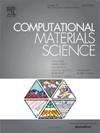Enhancing MXene-Based anodes with two-dimensional VO2/V2CO2 heterostructures: A first-principles calculations study
IF 3.1
3区 材料科学
Q2 MATERIALS SCIENCE, MULTIDISCIPLINARY
引用次数: 0
Abstract
The integration of MXene with complementary two-dimensional materials to form heterostructures has the potential to improve the electrochemical performance of MXene. In our study, we constructed a van der Waals heterostructure composed of VO2/V2CO2, and evaluated its effectiveness as an anode material for Li, Na, and Mg ion batteries through first-principles density functional theory simulations. Our findings reveal that the VO2/V2CO2 heterostructure demonstrates exceptional stability and inherent metallic characteristics. We identified diffusion barriers for Li, Na, and Mg ions within the interlayer to be relatively low—at 0.38 eV, 0.22 eV, and 0.51 eV, respectively—suggesting efficient ion transport. Furthermore, the average open-circuit voltages (OCVs) for Li-ion, Na-ion, and Mg-ion batteries were found to be between 0 and 1.5 V, which is advantageous for inhibiting lithium dendrite growth. Remarkably, the heterostructure showcases a theoretical storage capacity reaching up to 585mA h/g for Li, 351 mA h/g for Na, and an impressive 936 mA h/g for Mg adsorption—outstripping the capabilities of graphite and surpassing several other two-dimensional materials. These compelling results underscore the VO2/V2CO2 heterostructure as a highly promising anode material, particularly for Li-ion and Mg-ion battery applications.

求助全文
约1分钟内获得全文
求助全文
来源期刊

Computational Materials Science
工程技术-材料科学:综合
CiteScore
6.50
自引率
6.10%
发文量
665
审稿时长
26 days
期刊介绍:
The goal of Computational Materials Science is to report on results that provide new or unique insights into, or significantly expand our understanding of, the properties of materials or phenomena associated with their design, synthesis, processing, characterization, and utilization. To be relevant to the journal, the results should be applied or applicable to specific material systems that are discussed within the submission.
 求助内容:
求助内容: 应助结果提醒方式:
应助结果提醒方式:


